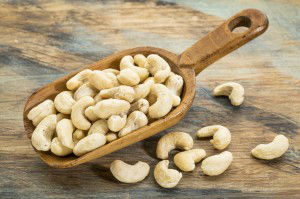
The cashew is a much-loved nut appreciated for its delicate flavor. Related to the pistachio, the cashew is actually a kidney-shaped seed that grows from the bottom of the fruit of the cashew tree, known as the cashew apple.
The cashew apple grows to about two to four inches in length. Practically unknown in North America, the cashew apple is a delicacy in areas of Brazil and the Caribbean where the cashew tree flourishes.
The cashew nut is double-shelled and sprouts from the bottom of the apple. When ripe, the cashew apples are allowed to fall from the tree for harvesting. The nuts are gathered and allowed to sun-dry for two days prior to being shelled.
Cashew nuts will always be sold shelled. The double shell is difficult to crack and the interior is filled with a resin called cashew balm. The resin is highly caustic and used in the industrial sector to make products such as insecticides and varnishes. Once the shell is removed the nuts are cleaned and an outer brown coating is removed. Cashews are often oil or dry-roasted, but health food stores and specialty shops carry the raw variety.
What’s inside?
Though a tough shell to crack, the cashew offers all the health benefits associated with the many other varieties of nuts, including:
- Monounsaturated fat
- Protein
- Copper
- Phosphorus
- Magnesium
- Manganese
- Zinc
Health benefits
Cashews are lower in fat than most other nut varieties, yet are comprised of 82 percent unsaturated fat. Sixty-six percent of the fat is of the heart-healthy monounsaturated variety, which has been found to lower blood triglyceride levels.
Triglycerides build up from a diet high in processed carbohydrates and fat; they can lead to plaque buildup and eventually be a cause of heart disease. When incorporated into a healthy diet plan, monounsaturated fats can help reduce the amount of triglyceride buildup in the blood.
Cashews are also an excellent source of copper, a key mineral that plays several roles in the body. Copper is responsible for aiding in bone and connective tissue production and growth.
It is also associated with many enzymatic processes throughout the body, one of which is producing the hair and skin pigment, melanin. A Copper deficiency is associated with osteoporosis, iron deficiency anemia, joint pain and irregular heartbeat.
Along with their high concentration of heart-healthy fats, researchers believe the combination of monounsaturated fat, protein and array of antioxidants aid in the cashew’s cardioprotective qualities.
One class of compounds, called proanthocyanidins, are flavanols found in abundance in the cashew nut. These compounds have been found to provide antioxidant support and stop the growth of cancer cells. Foods high in proanthocyanidins have been linked with a decreased risk for colon cancer.
Cashews are also a very good source of magnesium. Magnesium works in conjunction with calcium in a number of different roles in the body. Two-thirds of the body’s magnesium is found in the bones.
 A good portion is housed in the bones themselves while the remainder is found on the bone surface, waiting to be utilized in other areas. Magnesium helps regulate the calcium-induced stimulation of nerve and muscle cells. Without this regulation, calcium would overstimulate the nerves and muscles causing cramping, pain and spasm.
A good portion is housed in the bones themselves while the remainder is found on the bone surface, waiting to be utilized in other areas. Magnesium helps regulate the calcium-induced stimulation of nerve and muscle cells. Without this regulation, calcium would overstimulate the nerves and muscles causing cramping, pain and spasm.
Cashews are known for their delicate mild flavor. Raw cashews are a healthier option than roasted, since some of the nutrients can be lost during the roasting process. Cashew butter is also an excellent swap for peanut butter, but be sure to avoid heavily processed nuts or nut butters that incorporate added sugars, sweeteners or fillers.
-The Alternative Daily
Sources:
http://www.whfoods.com/genpage.php?tname=foodspice&dbid=98
http://www.healthdiaries.com/eatthis/7-health-benefits-of-cashews.html
http://nutisal.bg/page/7/history-of-nuts-cashews.html

